AMD Ryzen AI software heralds the arrival of five new CPUs — support for Strix Halo and Kraken Point chips added
AMD adds support for Strix Halo and Kraken Point CPUs.

As Hoang Anh Phu on X spotted, AMD's latest iteration of its Ryzen AI Software (version 1.2) adds support for new AMD silicon: Strix Halo and Kraken Point processors, which will compete against the best CPUs.
Patch notes reveal that AMD's latest version of its Ryzen AI software features support for five new AMD chips. One is a new chip based on AMD's older Phoenix silicon, while the latter four are all-new Zen 5 offerings. Two are Strix Point offerings featuring A0 and B0 steppings, while the last two chips are codenamed Strix Halo and "Krackan" (i.e., Kraken).
Strix Halo is the codename for an upcoming Zen 5 APU design from AMD that aims to compete squarely against Apple's latest iterations of its M-series silicon. Leaks have revealed that the chip is monstrously powerful for an AMD APU, boasting up to 16 Zen 5 cores (on two CCDs) and an iGPU that will seemingly rival the PlayStation 5, boasting 40 RDNA 3.5 compute units (which is more than the PS5 and the RX 7600 XT).
Originally, Strix Halo was believed to pack anywhere from 45 to 50 TOPS of NPU performance, but a newer leak from a highly reputable source claimed that Strix Halo will come with at least 70 TOPS of performance, which is 20 more TOPS than AMD's outgoing Ryzen AI 300 mobile CPUs.
Strix Halo could arrive with either LPDDR5X or LPDDR5 memory operating on a large 256-bit wide interface. So far, we've seen Strix Halo configurations boasting 128GB of memory, suggesting we could see Strix Halo-powered systems with up to 128GB of memory.
"Krackan" refers to AMD's leaked Kraken Point mobile APUs, which are rumored to arrive in 2025. This new Zen 5-powered design will reportedly be the successor to Hawk Point—the Ryzen 8040 series—and a like-for-like competitor to Intel's upcoming Lunar Lake architecture.
Kraken Point will allegedly prioritize power efficiency, boasting four Zen 5 cores and four Zen 5c cores, 16MB of L3 cache, and an RDNA 3.5 iGPU packing up to 8 compute units. These chips will be significantly weaker than AMD's existing Ryzen AI 9 300 series processors, which come with up to four Zen 5 cores, eight Zen 5c cores, 24MB of L3 cache, and up to AMD's Radeon 890M with 16 CUs.
Get Tom's Hardware's best news and in-depth reviews, straight to your inbox.
With the latest update for the Ryzen AI Software, AMD is laying the carpet for the chipmaker's upcoming Strix Halo and Kraken Point processors, which won't arrive until next year.

Aaron Klotz is a contributing writer for Tom’s Hardware, covering news related to computer hardware such as CPUs, and graphics cards.
-
usertests So what will be better, Kraken Point or Lunar Lake?Reply
It sounds to me like Lunar Lake could have better single-threaded performance and graphics than Kraken (4x Zen 5, 4x Zen 5c, 8 CUs RDNA3.5).
If that's the case, Kraken Point would have merit mostly by being cheaper. It could be used in handhelds better than a Steam Deck with better power efficiency than the Z1 Extreme handhelds. Valve itself probably won't use it because the graphics uplift isn't enough.
With the same 50 TOPS XDNA2, it will also make its way into overpriced Copilot+-ready laptops. Remember when AMD tried to pitch Mendocino for the $400-700 segment? Kra(c)ken isn't even the Mendocino sequel: Sonoma Valley.
Also, do we think "Bald Eagle Point" is real? Basically Strix Point + 16 MiB Infinity Cache.
which will compete against the best CPUs.
That was shoehorned in. -
Mattzun Is there any practical use for 50 TOPS or 70 TOPS on a laptop?Reply
Most people seem more interested in the long battery life on the Copilot laptops and the better integrated graphics on the new AMD chips than any AI feature -
usertests Reply
50 TOPS is more than what you are getting out of the iGPU, so it could be used for something like Stable Diffusion.Mattzun said:Is there any practical use for 50 TOPS or 70 TOPS on a laptop?
Most people seem more interested in the long battery life on the Copilot laptops and the better integrated graphics on the new AMD chips than any AI feature
In fact, AMD has their own software for people to do just that, with the NPU as a requirement for the "XDNA Super Resolution" step:
https://www.tomshardware.com/tech-industry/artificial-intelligence/amuse-20-beta-released-for-easy-on-device-ai-image-generation-on-modern-amd-hardware
If I got a laptop with this or a Strix "9700G" desktop APU, I would try generating images continuously with the NPU while playing a game. -
kealii123 Reply
If LLMs ever start running on the NPU, then yes. I would love using a version of copilot (the copilot for programmers) that runs locally, so theres less latency, longer context windows, and better understanding of my codebase. But until then, the only thing NPUs are good for is noise cancellation and background blur during zoom calls.Mattzun said:Is there any practical use for 50 TOPS or 70 TOPS on a laptop?
Most people seem more interested in the long battery life on the Copilot laptops and the better integrated graphics on the new AMD chips than any AI feature